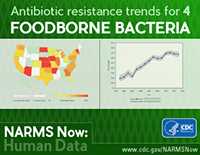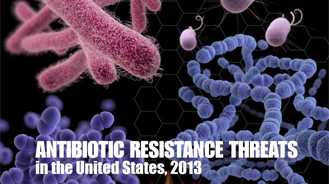Resources
On this Page
- Federal NARMS Partners
- Annual NARMS Reports
- Threats and Foodborne Germs
- CDC and Antimicrobial Resistance
- Antimicrobial Resistance Education
- International and Consensus Organizations
- Country-Specific Programs
NARMS Now: Human Data

Interactive tool from CDC that makes it easier to find out how antibiotic resistance for four bacteria transmitted commonly through food – Campylobacter, E. coli O157, Salmonella, and Shigella – has changed over the past 20 years.
Web, print, and other resources for partners and the public
Federal NARMS Partners
- FDA NARMS
FDA coordinates NARMS and leads the retail meat testing portion of the NARMS program - USDA NARMS
USDA leads the food animal sampling portion of the NARMS program
Annual NARMS Reports
- Interagency NARMS Executive Reports
- CDC NARMS Human Isolates Reports
- FDA NARMS Retail Meat Reports
- USDA NARMS Food Animal Reports
Threats and Foodborne Germs Report

This CDC report connects antibiotic resistance to foodborne and other enteric germs in animals, foods, and humans.
Download Report [PDF – 114 pages, 5.24 MB]
CDC and Antimicrobial Resistance
-
CDC’s Antibiotic/Antimicrobial Resistance Main Page
Part of CDC’s mission is to track the emergence of antimicrobial-resistant microorganisms and to limit their spread. This site gives information about what CDC is doing and what everyone can do to help combat antimicrobial resistance. -
Interagency Task Force on Antimicrobial Resistance (ITFAR)
ITFAR was created in 1999 to coordinate the activities of federal agencies in addressing antimicrobial resistance in recognition of the increasing importance of antimicrobial resistance as a public health threat. -
Public Health Action Plan to Combat Antimicrobial Resistance
The Action Plan is a blueprint for specific, coordinated federal actions to address the growing threat of antimicrobial resistance in the United States. -
Get Smart: Know When Antibiotics Work
This campaign aims to reduce the rising rate of antimicrobial resistance by promoting adherence to appropriate prescribing and usage guidelines. -
Get Smart for Healthcare: Know When Antibiotics Work
This program focuses on improving antibiotic use in inpatient healthcare facilities, starting with hospitals and then expanding to long-term care facilities. -
Antibiotic Resistance and Food Safety
Learn more about appropriate antibiotic use in veterinary medicine and animal agriculture.
Antimicrobial Resistance Education
-
Antimicrobial Resistance Learning Site for Veterinary Students (AMRLS)
This website is an open-source learning resource regarding antimicrobial use and antimicrobial resistance in animal agriculture and veterinary medicine. -
Animation of Antimicrobial Resistance, FDA Center for Veterinary Medicine (CVM)
This video explains how antimicrobial resistance emerges and proliferates among bacteria and how resistance complicates doctors’ efforts to select the appropriate drugs to treat patients with infections. - National Veterinary Accreditation Program Learning Module on Antibiotic Use in AnimalsThis educational module was developed for USDA by the Center for Food Security and Public Health at Iowa State University. It contains information on: selection of antibiotics for veterinary use, descriptions of antibiotic susceptibility testing methods, lists of agencies involved in regulating antibiotics, and more.
International and Consensus Organizations
-
World Health Organization Advisory Group on Integrated Surveillance of Antimicrobial Resistance (WHO-AGISAR)
AGISAR is an international group of experts that advises WHO on integrated surveillance of antimicrobial resistance and the containment of food-related antimicrobial resistance. -
Global Health Unit (GHU)
Countries with effective laboratory and public health resources are better-equipped to prevent, detect and respond to the threat of diarrheal diseases. The Global Health Unit (GHU) works with ministries of health in various countries to develop those resources internationally.. -
Transatlantic Taskforce on Antimicrobial Resistance (TATFAR)
The objectives of this task force are to increase the mutual understanding of US and EU activities and programs relevant to the antimicrobial resistance issues. The main outcome of the taskforce is a report, including a set of recommendations for future cooperation in the global fight to keep antimicrobials effective. -
World Organisation for Animal Health (OIE
This is an intergovernmental organization responsible for improving animal health worldwide. -
The European Surveillance of Veterinary Antimicrobial Consumption (ESVAC)
This project collects information on how antimicrobial medicines are used in animals across the European Union (EU). This type of information is essential to identify possible risk factors that could lead to the development and spread of antimicrobial resistance in animals. -
European Committee on Antimicrobial Susceptibility Testing (EUCAST)
EUCAST is a standing committee that deals with breakpoints and technical aspects of phenotypic in vitro antimicrobial susceptibility testing. -
European Food Safety Agency (EFSA)
EFSA is a Biological Monitoring Unit that monitors and analyzes the situation on antimicrobial resistance in food and animals across Europe. -
European Antimicrobial Resistance Surveillance Network (EARS-Net)
This is a European wide network of national surveillance systems, providing European reference data on antimicrobial resistance for public health purposes.
Country-Specific Programs
-
Canadian Integrated Program for Antimicrobial Resistance Surveillance (CIPARS)
This program monitors trends in antimicrobial use and antimicrobial resistance in selected bacterial organisms from human, animal, and food sources across Canada. -
Colombian Integrated Program for Antimicrobial Resistance Surveillance (COIPARS) (In Spanish)
This program maintains information on resistant bacteria from humans, animals, and animal products and monitors trends in antimicrobial resistance. -
Danish Integrated Antimicrobial Resistance Monitoring and Research Programme (DANMAP)
This program conducts surveillance of antimicrobial consumption and resistance in bacteria from animals, food, and humans. -
Norwegian Veterinary Institute, Report of Usage of Antimicrobial Agents and Occurrence of Antimicrobial Resistancein Norway
This national health registry collects data about antibiotic resistance of bacterial isolates from animals and humans to determine the incidence and prevalence of antibiotic resistance and monitor changes over time. -
Swedish Veterinary Antimicrobial Resistance Monitoring Programme (SVARM)
This program monitors and analyzes the development of antimicrobial resistance in bacteria from animals and in bacteria from food of animal origin. Results are published in a yearly report.
- Page last reviewed: August 19, 2015
- Page last updated: April 7, 2016
- Content source:



 ShareCompartir
ShareCompartir
